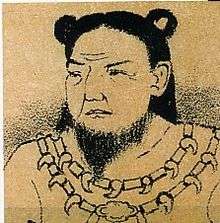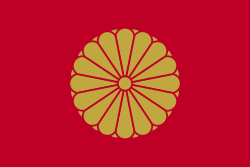Emperor Kōshō
Emperor Kōshō (孝昭天皇, Kōshō-tennō), also known as Mimatsuhikokaeshine no Mikoto (真津日子訶恵志泥命) was the fifth Emperor of Japan, according to the traditional order of succession.[3][4] Very little is known about this Emperor due to a lack of material available for further verification and study. Kōshō is known as a "legendary emperor" among historians as his actual existence is disputed. Nothing exists in the Kojiki other than his name and genealogy. Kōshō's reign allegedly began in 475 BC, he had one wife and two sons. After his death in 393 BC, his second son supposedly became the next emperor.[5]
| Kōshō | |
|---|---|
 | |
| Emperor of Japan | |
| Reign | 475 BC – 393 BC (traditional)[1] |
| Predecessor | Itoku |
| Successor | Kōan |
| Born | 501 BC[2] |
| Died | 393 BC (aged 108) |
| Burial | Waki-no-kami no Hakata no yama no e no misasagi (掖上博多山上陵) (Gose) |
| Spouse | Yosotarashi-hime |
| Issue | |
| House | Imperial House of Japan |
| Father | Emperor Itoku |
| Mother | Amonotoyototsu-hime |
| Religion | Shinto |
Legendary narrative
In the Kojiki and Nihon Shoki, only his name and genealogy were recorded. The Japanese have traditionally accepted this sovereign's historical existence, and an Imperial misasagi or tomb for Kōshō is currently maintained; however, no extant contemporary records have been discovered that confirm a view that this historical figure actually reigned. Kōshō is believed to be the oldest son of Emperor Itoku, and his wife Amanotoyototsu-hime. His mother was the daughter of Okishimimi-no-kami.[5][6] The Kojiki records that he ruled from the palace of Ikekokoro-no-miya (葛城掖上宮, and in the Nihon Shoki as 掖上池心宮) at Waki-no-kami in what would come to be known as Yamato Province.[4][6] Kōshō allegedly had a wife named Yosotarashi-hime, and fathered two children with her. His reign lasted from 475 BC until his death in 393 BC, his second son then took the throne and would later be referred to as Emperor Kōan.
Known information
The existence of at least the first nine Emperors is disputed due to insufficient material available for further verification and study.[7] Kōshō is thus regarded by historians as a "legendary Emperor", and is considered to have been the fourth of eight Emperors without specific legends associated with them.[lower-alpha 1] The name Kōshō-tennō was assigned to him posthumously by later generations, and literally means "filial manifestation".[9] His name might have been regularized centuries after the lifetime ascribed to Kōshō, possibly during the time in which legends about the origins of the Yamato dynasty were compiled as the chronicles known today as the Kojiki.[8] While the actual site of Kōshō's grave is not known, the Emperor is traditionally venerated at a memorial Shinto shrine (misasagi) in Gose.[3] The Imperial Household Agency designates this location as Kōshō's mausoleum. It is formally named Waki-no-kami no Hakata no yama no e no misasagi.[5] There is a possibility that this figure could have lived instead in the 1st century (AD), however more research is needed to make any further conclusions.[10]
The first emperor that historians state might have actually existed is Emperor Sujin, the 10th emperor of Japan.[11] Outside of the Kojiki, the reign of Emperor Kinmei[lower-alpha 2] (c. 509 – 571 AD) is the first for which contemporary historiography is able to assign verifiable dates.[14] The conventionally accepted names and dates of the early Emperors were not confirmed as "traditional" though, until the reign of Emperor Kanmu[lower-alpha 3] between 737 and 806 AD.[8]
Consorts and Children
- Empress: Yosotarashi-hime (世襲足媛), Owari clan's daughter
- First Son: Prince Ametarashihikokunioshihito (天足彦国押人命)
- Second Son: Prince Yamatotarashihikokunioshihito (日本足彦国押人尊), later Emperor Koan
See also
- Emperor of Japan
- List of Emperors of Japan
- Imperial cult
Notes
References

- ""Genealogy of the Emperors of Japan"" (PDF). Kunaicho.go.jp. Retrieved May 8, 2019.
- Kenneth Henshall (2013). Historical Dictionary of Japan to 1945. Scarecrow Press. p. 487.
- "孝昭天皇 (5)". Imperial Household Agency (Kunaichō) (in Japanese). Retrieved May 9, 2019.
- Brown, Delmer M. and Ichirō Ishida (1979). A Translation and Study of the Gukanshō, an Interpretative History of Japan Written in 1219. University of California Press. p. 251.
- Ponsonby-Fane, Richard (1959). The Imperial House of Japan. Ponsonby Memorial Society. p. 30 & 418.
- Varley, H. Paul. (1980). Jinnō Shōtōki: A Chronicle of Gods and Sovereigns. Columbia University Press. p. 90.
- Kelly, Charles F. ""Kofun Culture"". www.t-net.ne.jp. Retrieved May 8, 2019.
- Aston, William George. (1896). Nihongi: Chronicles of Japan from the Earliest Times to A.D. 697, Volume 2. The Japan Society London. pp. 109, 144–145.
- Brinkley, Frank (1915). A History of the Japanese People from the Earliest Times to the end of the Meiji Era. Encyclopaedia Britannica Company. p. 21.
Posthumous names for the earthly Mikados were invented in the reign of Emperor Kanmu (782–805), i.e., after the date of the compilation of the Records and the Chronicles.
- Nussbaum, Louis-Frédéric. (2005). "Kōshō Tennō" in Japan Encyclopedia, p. 564, p. 564, at Google Books.
- Yoshida, Reiji. (March 27, 2007). ""Life in the Cloudy Imperial Fishbowl"". Japan Times. Retrieved May 16, 2019.
- Titsingh, Isaac. (1834). Nihon Ōdai Ichiran (in French). Royal Asiatic Society, Oriental Translation Fund of Great Britain and Ireland. pp. 34–36.
- Brown, Delmer M. and Ichirō Ishida (1979). A Translation and Study of the Gukanshō, an Interpretative History of Japan Written in 1219. University of California Press. pp. 261–262.
- Hoye, Timothy. (1999). Japanese Politics: Fixed and Floating Worlds. Prentice Hall. p. 78.
According to legend, the first Japanese Emperor was Jimmu. Along with the next 13 Emperors, Jimmu is not considered an actual, historical figure. Historically verifiable Emperors of Japan date from the early sixth century with Kimmei.
Further reading
- Aston, William George. (1896). Nihongi: Chronicles of Japan from the Earliest Times to A.D. 697. London: Kegan Paul, Trench, Trubner. OCLC 448337491
- Brown, Delmer M. and Ichirō Ishida, eds. (1979). Gukanshō: The Future and the Past. Berkeley: University of California Press. ISBN 978-0-520-03460-0; OCLC 251325323
- Chamberlain, Basil Hall. (1920). The Kojiki. Read before the Asiatic Society of Japan on April 12, May 10, and June 21, 1882; reprinted, May, 1919. OCLC 1882339
- Nussbaum, Louis-Frédéric and Käthe Roth. (2005). Japan encyclopedia. Cambridge: Harvard University Press. ISBN 978-0-674-01753-5; OCLC 58053128
- Ponsonby-Fane, Richard Arthur Brabazon. (1959). The Imperial House of Japan. Kyoto: Ponsonby Memorial Society. OCLC 194887
- Titsingh, Isaac. (1834). Nihon Ōdai Ichiran; ou, Annales des empereurs du Japon. Paris: Royal Asiatic Society, Oriental Translation Fund of Great Britain and Ireland. OCLC 5850691
- Varley, H. Paul. (1980). Jinnō Shōtōki: A Chronicle of Gods and Sovereigns. New York: Columbia University Press. ISBN 978-0-231-04940-5; OCLC 59145842
| Regnal titles | ||
|---|---|---|
| Preceded by Emperor Itoku |
Legendary Emperor of Japan 475 BC – 393 BC (traditional dates) |
Succeeded by Emperor Kōan |
